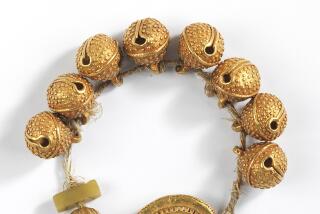Alert out for at-risk Afghan art
AFGHANISTAN is far from the only country to suffer from looting and illicit trafficking of its cultural heritage, but it is going under a spotlight.
The “Red List of Afghanistan Antiquities at Risk,” an illustrated guide to endangered objects published by the Paris-based International Council of Museums, will be launched by the U.S. Committee of ICOM and the American Assn. of Museums today in Washington, D.C.
Produced in consultation with scholars and archeologists to raise public awareness of illegal trade and provide a resource for law enforcement officers, the list presents 18 categories of art and artifacts deemed most likely to be looted or stolen.
The oldest objects, made before the arrival of Islam, include ancient pottery, metal jars, statuettes, reliquaries, seals, coins, wall painting fragments and Buddhist sculpture. Islamic works on the list encompass manuscripts, bronze and copper vessels, glazed ceramic tiles, pottery and stone architectural elements.
ICOM is an international organization of museums that focuses on natural- and cultural-heritage issues. Its U.S. committee operates under the umbrella of the Washington, D.C.-based American Assn. of Museums, which develops museum standards and advocates on issues of concern to members. The joint announcement of the Afghanistan list is intended to alert the public to one aspect of a complex problem.
“Looted cultural objects tend to move through smuggling networks,” says Erik Ledbetter, AAM’s senior manager of international programs. “Dealing with any small object where the payoff is worth the risk of trying to take it across a border goes hand-in-glove with other kinds of illicit trade. The Red List helps officers recognize things as they come through customs and arms them with information needed to choke off this trade.”
The Afghanistan list is fourth in a series, published as a booklet and CD-ROM in four languages. The first two lists covered Africa and Latin America. Next came the “Emergency Red List of Iraqi Antiquities at Risk.” A Red List for Peru will be published next year.
“It’s an ongoing process of consciousness raising about how serious a problem looting is,” Ledbetter says. “I sometimes think the change in values that this promotes is as important as any individual seizure.”
More to Read
The biggest entertainment stories
Get our big stories about Hollywood, film, television, music, arts, culture and more right in your inbox as soon as they publish.
You may occasionally receive promotional content from the Los Angeles Times.










